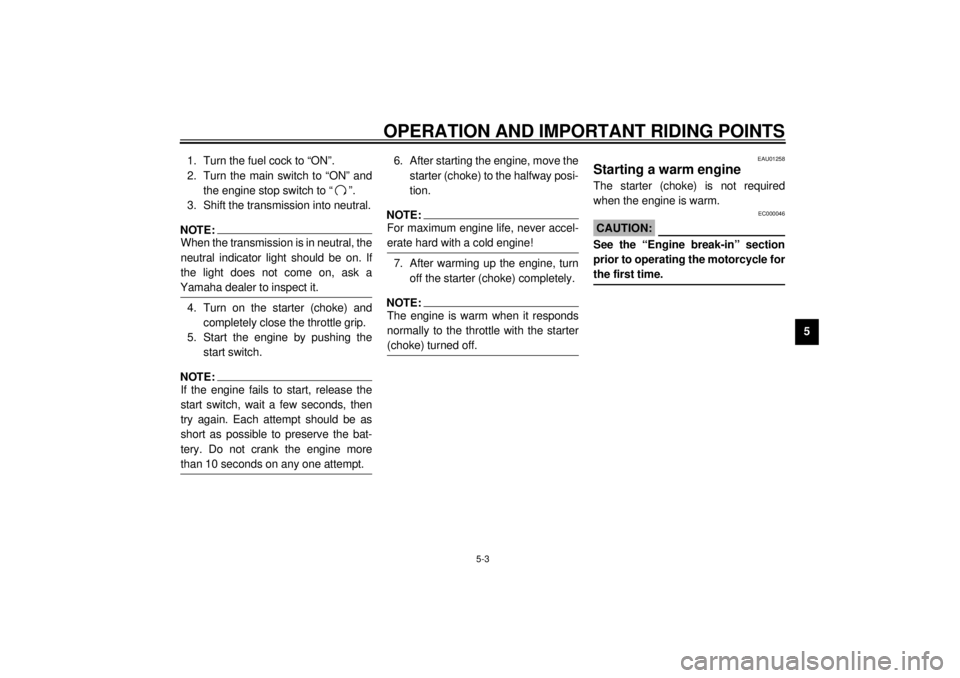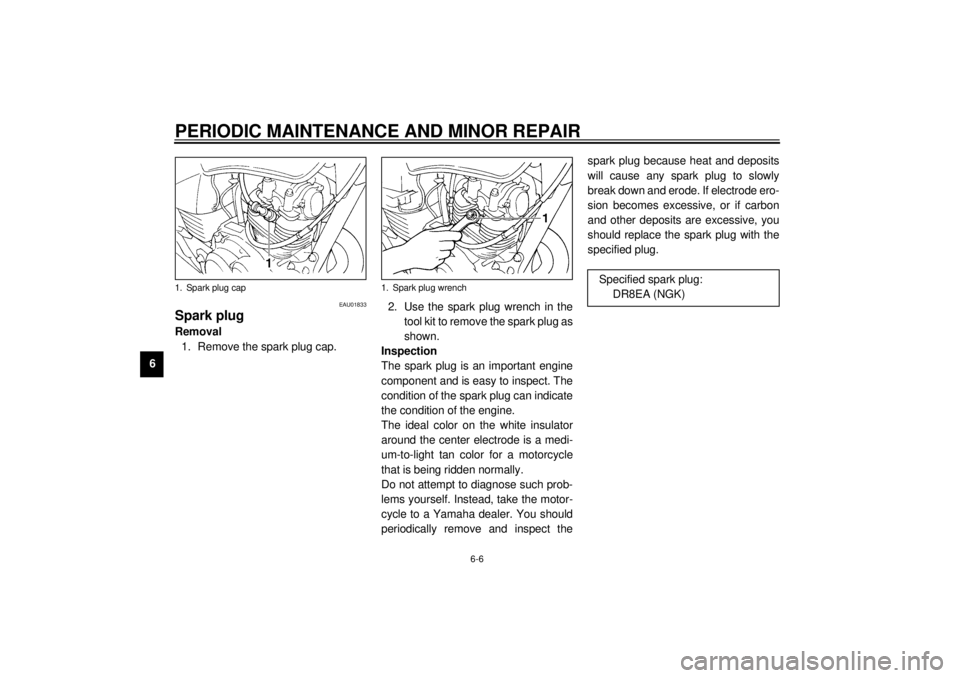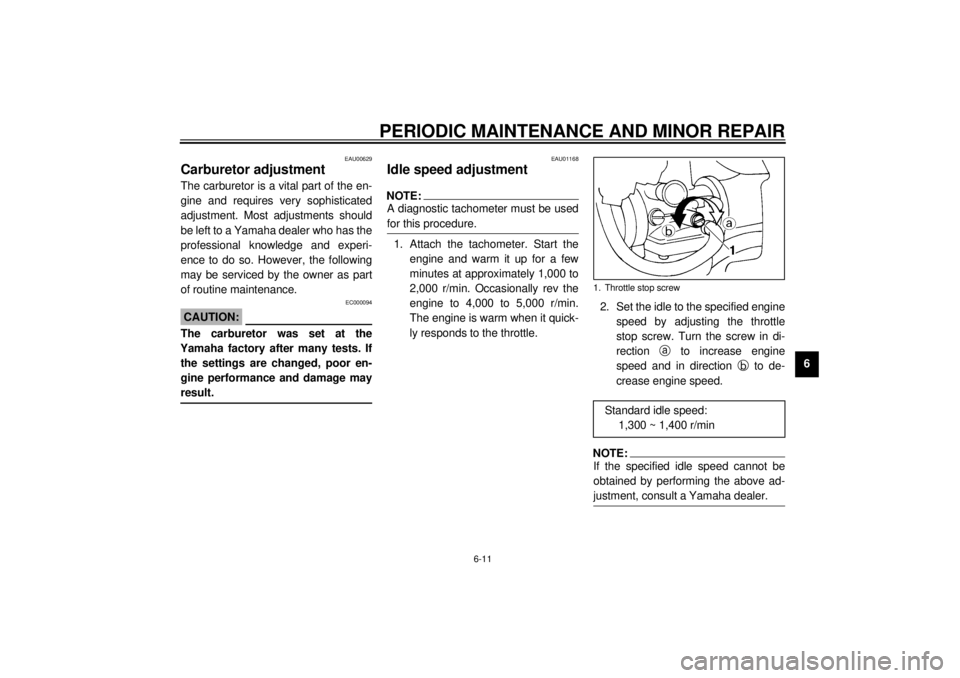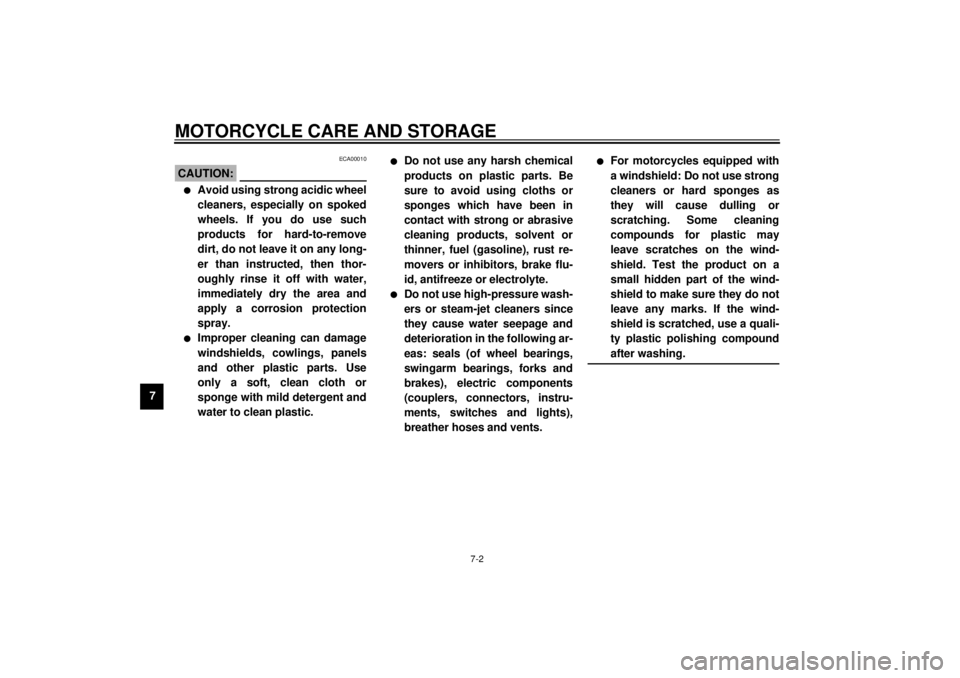ESP YAMAHA SR125 2000 Owners Manual
[x] Cancel search | Manufacturer: YAMAHA, Model Year: 2000, Model line: SR125, Model: YAMAHA SR125 2000Pages: 78, PDF Size: 8.59 MB
Page 23 of 78

4-1
4
EAU01114
4-PRE-OPERATION CHECKS
Owners are personally responsible for their vehicle’s condition. Your motorcycle’s vital functions can start to deteriorate
quickly and unexpectedly, even if it remains unused (for instance, if it is exposed to the elements). Any damage, fluid leak or
loss of tire pressure could have serious consequences. Therefore, it is very important that, in addition to a thorough visual in-
spection, you check the following points before each ride.
EAU00340
PRE-OPERATION CHECK LIST
ITEM CHECKS PAGE
Front brake• Check operation, free play, fluid level and fluid leakage.
• Fill with DOT 4 (or DOT 3) brake fluid if necessary.
6-16 ~ 6-20
Rear brake• Check operation, condition and free play.
• Adjust if necessary.
Clutch• Check operation, condition and free play.
• Adjust if necessary.6-16
Throttle grip and housing• Check for smooth operation.
• Lubricate if necessary.6-23
Engine oil• Check oil level.
• Fill with oil if necessary.6-8 ~ 6-9
Drive chain• Check chain slack and condition.
• Adjust if necessary.6-21 ~ 6-23
Wheels and tires• Check tire pressure, wear, damage and spoke tightness.
• Tighten spokes if necessary.6-13 ~ 6-15, 6-30 ~ 6-33
Control and meter cables• Check for smooth operation.
• Lubricate if necessary.6-23
Brake and shift pedal
shafts• Check for smooth operation.
• Lubricate if necessary.6-24
Brake and clutch lever
pivots• Check for smooth operation.
• Lubricate if necessary.6-24
E_3mw.book Page 1 Monday, February 5, 2001 9:54 AM
Page 27 of 78

OPERATION AND IMPORTANT RIDING POINTS
5-3
5 1. Turn the fuel cock to “ON”.
2. Turn the main switch to “ON” and
the engine stop switch to “ ”.
3. Shift the transmission into neutral.
NOTE:@ When the transmission is in neutral, the
neutral indicator light should be on. If
the light does not come on, ask a
Yamaha dealer to inspect it. @4. Turn on the starter (choke) and
completely close the throttle grip.
5. Start the engine by pushing the
start switch.NOTE:@ If the engine fails to start, release the
start switch, wait a few seconds, then
try again. Each attempt should be as
short as possible to preserve the bat-
tery. Do not crank the engine more
than 10 seconds on any one attempt. @
6. After starting the engine, move the
starter (choke) to the halfway posi-
tion.NOTE:@ For maximum engine life, never accel-
erate hard with a cold engine! @7. After warming up the engine, turn
off the starter (choke) completely.NOTE:@ The engine is warm when it responds
normally to the throttle with the starter
(choke) turned off. @
EAU01258
Starting a warm engineThe starter (choke) is not required
when the engine is warm.
EC000046
CAUTION:@ See the “Engine break-in” section
prior to operating the motorcycle for
the first time. @
E_3mw.book Page 3 Monday, February 5, 2001 9:54 AM
Page 36 of 78

PERIODIC MAINTENANCE AND MINOR REPAIR
6-6
6
EAU01833
Spark plugRemoval
1. Remove the spark plug cap.2. Use the spark plug wrench in the
tool kit to remove the spark plug as
shown.
Inspection
The spark plug is an important engine
component and is easy to inspect. The
condition of the spark plug can indicate
the condition of the engine.
The ideal color on the white insulator
around the center electrode is a medi-
um-to-light tan color for a motorcycle
that is being ridden normally.
Do not attempt to diagnose such prob-
lems yourself. Instead, take the motor-
cycle to a Yamaha dealer. You should
periodically remove and inspect thespark plug because heat and deposits
will cause any spark plug to slowly
break down and erode. If electrode ero-
sion becomes excessive, or if carbon
and other deposits are excessive, you
should replace the spark plug with the
specified plug.1. Spark plug cap
1. Spark plug wrench
Specified spark plug:
DR8EA (NGK)
E_3mw.book Page 6 Monday, February 5, 2001 9:54 AM
Page 41 of 78

PERIODIC MAINTENANCE AND MINOR REPAIR
6-11
6
EAU00629
Carburetor adjustmentThe carburetor is a vital part of the en-
gine and requires very sophisticated
adjustment. Most adjustments should
be left to a Yamaha dealer who has the
professional knowledge and experi-
ence to do so. However, the following
may be serviced by the owner as part
of routine maintenance.
EC000094
CAUTION:@ The carburetor was set at the
Yamaha factory after many tests. If
the settings are changed, poor en-
gine performance and damage may
result. @
EAU01168
Idle speed adjustmentNOTE:@ A diagnostic tachometer must be used
for this procedure. @1. Attach the tachometer. Start the
engine and warm it up for a few
minutes at approximately 1,000 to
2,000 r/min. Occasionally rev the
engine to 4,000 to 5,000 r/min.
The engine is warm when it quick-
ly responds to the throttle.2. Set the idle to the specified engine
speed by adjusting the throttle
stop screw. Turn the screw in di-
rection
a to increase engine
speed and in direction
b to de-
crease engine speed.
NOTE:@ If the specified idle speed cannot be
obtained by performing the above ad-
justment, consult a Yamaha dealer. @1. Throttle stop screwStandard idle speed:
1,300 ~ 1,400 r/min
E_3mw.book Page 11 Monday, February 5, 2001 9:54 AM
Page 66 of 78

MOTORCYCLE CARE AND STORAGE
7-2
7
ECA00010
CAUTION:@ l
Avoid using strong acidic wheel
cleaners, especially on spoked
wheels. If you do use such
products for hard-to-remove
dirt, do not leave it on any long-
er than instructed, then thor-
oughly rinse it off with water,
immediately dry the area and
apply a corrosion protection
spray.
l
Improper cleaning can damage
windshields, cowlings, panels
and other plastic parts. Use
only a soft, clean cloth or
sponge with mild detergent and
water to clean plastic.
l
Do not use any harsh chemical
products on plastic parts. Be
sure to avoid using cloths or
sponges which have been in
contact with strong or abrasive
cleaning products, solvent or
thinner, fuel (gasoline), rust re-
movers or inhibitors, brake flu-
id, antifreeze or electrolyte.
l
Do not use high-pressure wash-
ers or steam-jet cleaners since
they cause water seepage and
deterioration in the following ar-
eas: seals (of wheel bearings,
swingarm bearings, forks and
brakes), electric components
(couplers, connectors, instru-
ments, switches and lights),
breather hoses and vents.
l
For motorcycles equipped with
a windshield: Do not use strong
cleaners or hard sponges as
they will cause dulling or
scratching. Some cleaning
compounds for plastic may
leave scratches on the wind-
shield. Test the product on a
small hidden part of the wind-
shield to make sure they do not
leave any marks. If the wind-
shield is scratched, use a quali-
ty plastic polishing compound
after washing.
@
E_3mw.book Page 2 Monday, February 5, 2001 9:54 AM